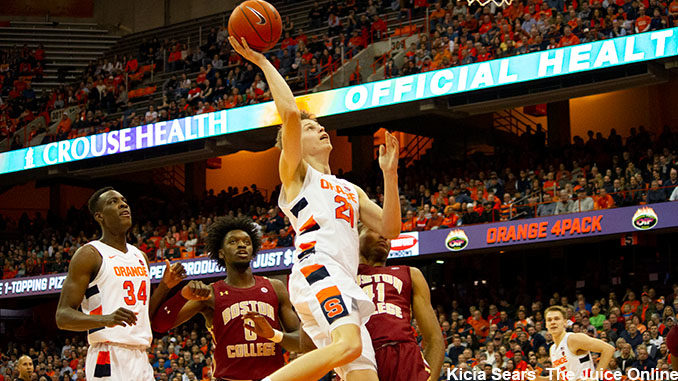
Due to COVID-19, we never got to see how the 2019-2020 season would turn out for Syracuse basketball. But despite finishing with a win over North Carolina, the season was by all respects a disappointment.
Syracuse finished 18-14 — a .563 winning percentage which ranked the third-worst in Jim Boeheim’s 44 seasons. In fact, six of the worst 10 Boeheim teams by winning percentage have come in the last six seasons (not coincidentally, these were all after the NCAA sanctions were announced).
So what will it take to turn Syracuse around?
Boeheim’s best single-year turnaround by win percentage coincided with his best season overall: the 2002-2003 National Championship squad. There’s no secret what the source of the turnaround was: the most transcendent freshman in the history of SU basketball.
But as much as we can hope that SU signees Kadary Richmond and Woody Newton turn out to be good players, Carmelo Anthony they are not.
The next best turnaround in Boeheim’s career had happened just three years earlier in the 1999-2000 season. This season perhaps provides a more viable pathway for Syracuse’s return to relevance — at least until hyped 2022 5-star recruit Dior Johnson steps foot on campus.
The year prior, Boeheim’s last team of the century had not been terrible. They won 21 games and earned an 8 seed in the NCAA tournament, where they lost in the first round. But that team did not have a single senior and struggled with offensive consistency.
» Related: Former Syracuse star Josh Pace is now coaching in New Mexico
SU’s 99-00 roster returned all five starters, including seniors Jason Hart, Ryan Blackwell, and Etan Thomas. The team proved to be one of Boeheim’s best defensive units, giving up just 63 points per game and anchored by Thomas, who would win his second straight Big East Defensive Player of the Year trophy before continuing on to a long NBA career.
Boeheim also gave playing time to multiple developing young talents, including sophomore Preston Shumpert and freshman DeShaun Williams.
The team eventually won the Big East regular season title — reaching as high as 4th in the AP poll — and bowed out in the Regional Semifinal of the NCAA Tournament as a 4-seed.
The lesson is that experienced upperclassmen who have been through difficult seasons can eventually turn the ship around.
With Elijah Hughes (rightly) bound for the NBA, next year’s Orange will not return all five starters. But they will likely return four starters, including two seniors and a junior.
Without Hughes, as well as transfers Brycen Goodine, Jalen Carey and Howard Washington, the Syracuse offense will look quite different. But if SU’s rising seniors continue to improve while the rising sophomores take a leap, there is some hope that SU could field a better team than last year — even if SU is likely to find itself once again on the bubble of the NCAA Tournament.
The next best turnaround in Boeheim’s tenure came in 1997-1998. But this resurgance had more to do with the seasons before it than anything else.
In 96-97, Syracuse was coming off an appearance in the National Championship game. Star John Wallace and senior point guard Lazarus Sims had graduated and the bench was thin. Numerous challenges, including rebounding, doomed the Orange to Boeheim’s first NIT appearance since 1982.
The big bounce back the following year was more a reversion to the mean than anything else. The team rode senior swingman Todd Burgan and the emerging sophomore trio of Hart, Blackwell and Thomas to the Sweet Sixteen. Ironically, perhaps — for those who these days wonder why Boeheim never switches to man-to-man defense — the 97-98 squad was one of the few SU teams that Boeheim did consistently commit to playing man.
Had Hughes returned, perhaps he could have been the Burgan on next year’s team. Had Goodine not transferred, perhaps he could have developed into its Hart. But with them gone, the 97-98 squad holds few lessons for how next year’s team could bounce back to prominence.
So where to look for hope?
Perhaps the answer is just three years ago: the 2017-2018 squad. Like this past season, the prior year had been a disaster that ended in the NIT. Likewise, Syracuse did not return its top scorer — in that case, Andrew White III. There were low expectations, just as there will be for next season.
But the 17-18 Orange cobbled together a mix of a developing star (Tyus Battle), veteran upperclassmen (Paschal Chukwu and Frank Howard), and young talent (Oshae Brissett and Dolezaj) to make it to the Sweet Sixteen. It wasn’t always pretty, but it was a season to remember.
This coming season, perhaps Quincy Guerrier could make the leap to ascendant star, while Sidibe, Dolezaj and Buddy Boeheim provide veteran leadership. Incoming freshman Richmand may surprise as a young talent, while Joe Girard III will continue to develop.
This is not the recipe for success you probably wanted to hear. I get that.
Regardless of what happens, Syracuse is unlikely to be in the mix for the top-25 next season. But Boeheim teams have bounced back before, and Syracuse has some pieces that could make next season more exciting than this past one.
For more Syracuse coverage, Like our Facebook page and follow us @TheJuiceOnline.

